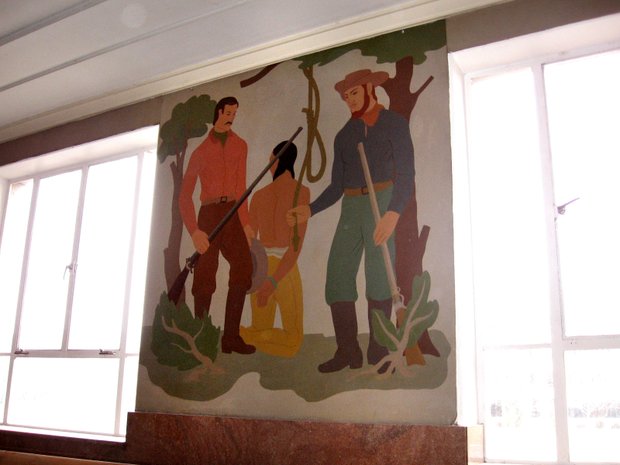Preservation group objects to covering lynching murals in new law center
Preservation Idaho, the state’s leading historic preservation group, has sent a letter to University of Idaho officials asking them not to cover two historic murals depicting the lynching of a Native American man in the former Ada County Courthouse when it reopens as the new Idaho Law & Justice Learning Center later this summer, with occupants including the UI College of Law and some operations of the Idaho Supreme Court. “Idahoans have not destroyed the sites of the Bear River Massacre, the Minidoka Internment Camp, or Massacre Rocks State Park,” said the letter from the group’s president, Paula Benson. “We deplore what happened at the sites but we acknowledge them so that we may reflect and learn from past mistakes.”
 She added, “History may not always be packaged as we would like, but it enables us to learn valuable lessons. Idaho’s history, embodied by these murals, should be honored, interpreted, and left in place.” You can read the full letter here. It notes that in 2007, before the Idaho Legislature held its sessions in the building for two years, extended negotiations between the Legislature, the state Historical Society, Idaho’s Native American tribes, and Preservation Idaho resulted in a decision to leave the murals uncovered but to add interpretive plaques prepared by the Historical Society and approved by the tribes; those plaque are still there.
She added, “History may not always be packaged as we would like, but it enables us to learn valuable lessons. Idaho’s history, embodied by these murals, should be honored, interpreted, and left in place.” You can read the full letter here. It notes that in 2007, before the Idaho Legislature held its sessions in the building for two years, extended negotiations between the Legislature, the state Historical Society, Idaho’s Native American tribes, and Preservation Idaho resulted in a decision to leave the murals uncovered but to add interpretive plaques prepared by the Historical Society and approved by the tribes; those plaque are still there.
Lee Dillion, associate dean for Boise programs of the University of Idaho College of Law, to whom the letter was addressed, referred questions about it to university spokeswoman Stefany Bales in Moscow, who said Benson made good points in her “very thoughtful” letter. Oppression of Native Americans by settlers is “a painful part of our history that we don’t want to forget, and she’s right about that,” Bales said. “There was a meaningful conversation that took place” about the murals in 2007, Bales said, but now, she said, the use of the building is changing. “It’s not necessarily a building with public foot traffic. It’s a very specific group of people using the building. So it seems to us that it’s time to have another conversation about what to do with that mural, whether to leave it visible or not. And that’s a conversation that has to happen with a group of stakeholders that I would suspect would look very much like the last group that came together to talk about it.”
She added, “It won’t be uncovered for the opening. … We did agree to temporarily cover them until we determine what the future should be, longer term.”
Bob Geddes, the new director of the state Department of Administration – which owns the building on behalf of the state, and is leasing it to the UI College of Law and the Idaho Supreme Court as tenants – said, “Certainly we can’t destroy those murals. There’s value in those murals, and that was established.” He said, “I can fully understand that some people are offended by those murals, and other people value them as valuable art.”
For now, he said, “We’ve given them the go-ahead if they want to drape those with something, but they should not destroy them or take away the plaques.” That way, he said, “If someone wants to see them, they can look at those.”
The issue is familiar to Geddes – he was the president pro-tem of the Idaho Senate back in 2007, and participated in the talks about the murals then. “I think the plaques that were displayed with those murals accurately describe kind of the sentiment of what most stakeholders agreed was acceptable,” he said. “I guess we may have to do that process yet one more time.” With a chuckle, he added, “It’s nice to be in a job that I have some experience.”
“Quite honestly, I think probably if the university went through that stakeholder process, I think they would find the same thing, and they’re already finding that sentiment,” Geddes said. “So maybe we’ll have to be a little less sensitive but understand the perspective, perhaps, of the artists and the fact that the history is what it is.”
Former Idaho Chief Justice Linda Copple Trout, who is now acting administrative director of the state courts, said she queried the Idaho Supreme Court justices about the murals earlier and they agreed to drape the two depicting the lynching with banners for the building’s opening. “Because something is wrong and offensive, just because it’s historical does not mean that we should honor that,” she said. But she added, “I think it’s always appropriate to talk to all of the stakeholders.”
